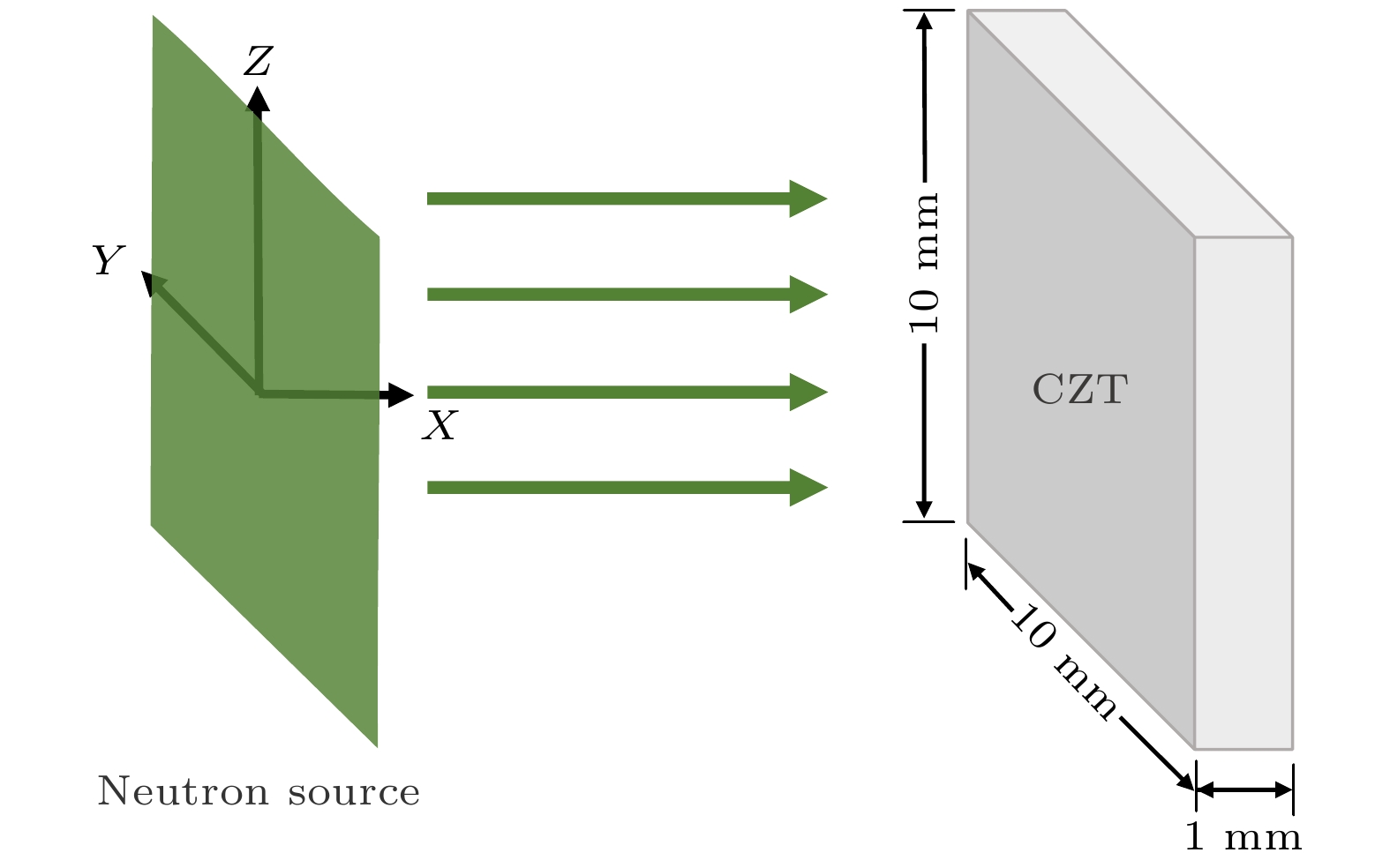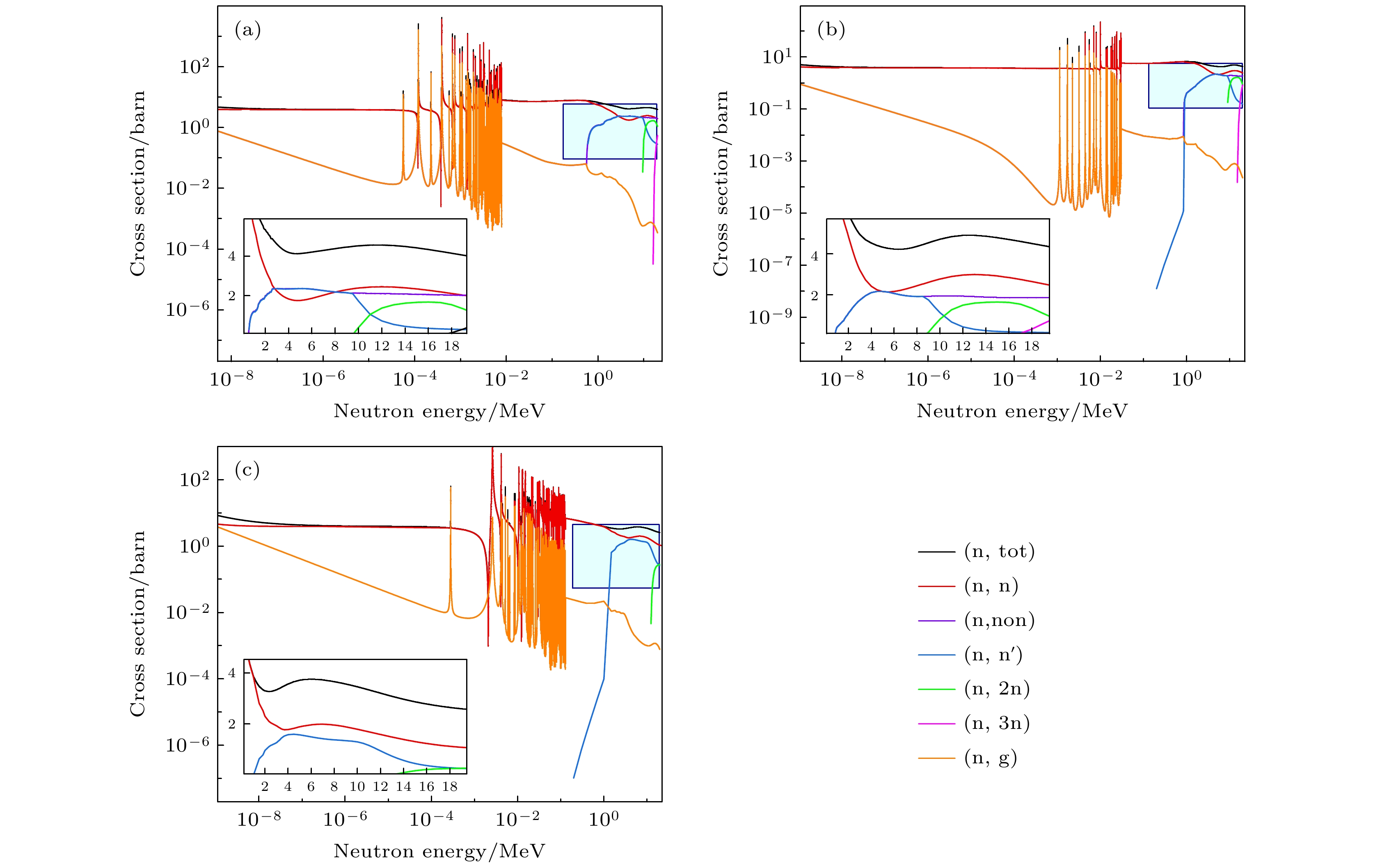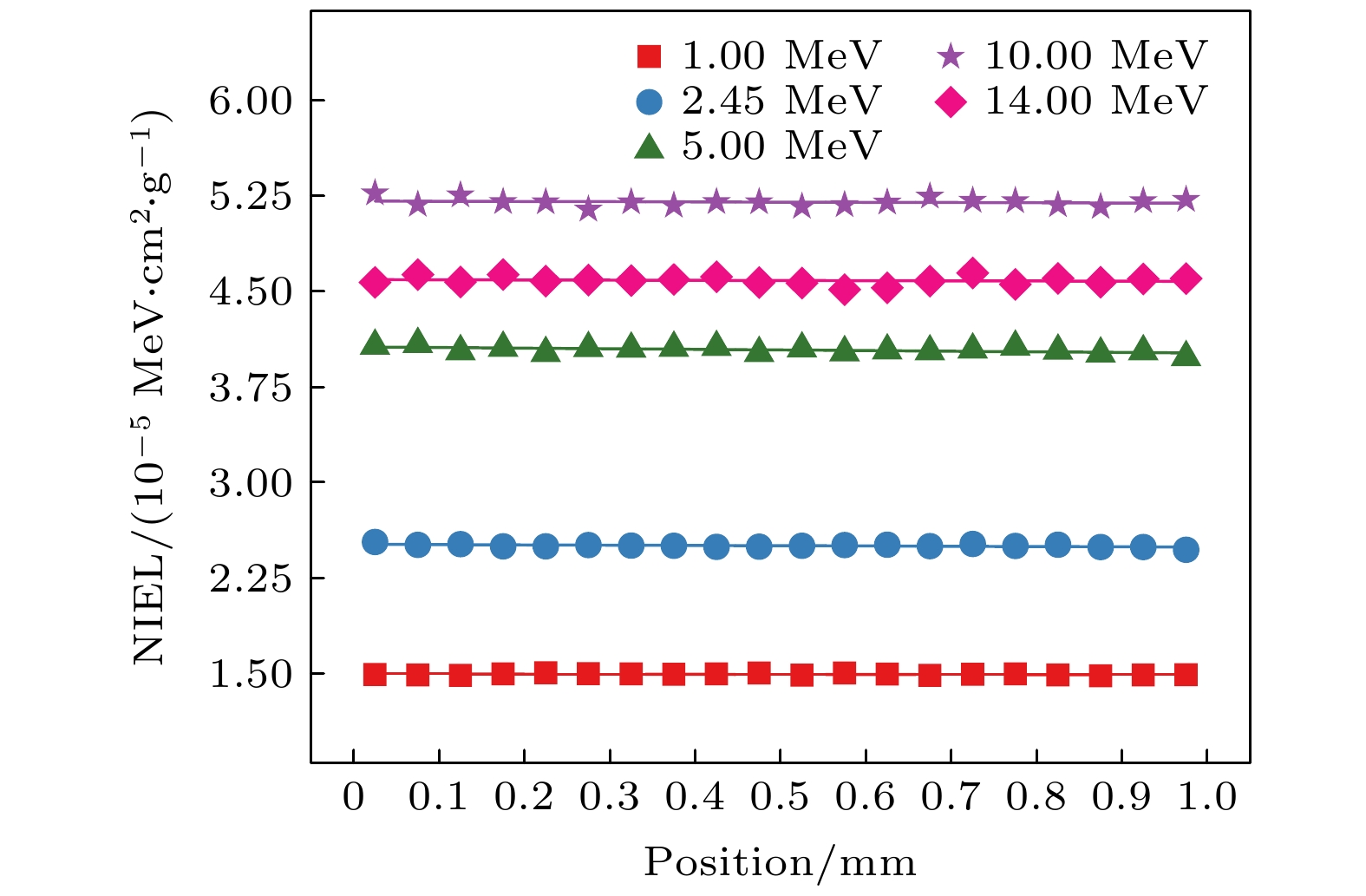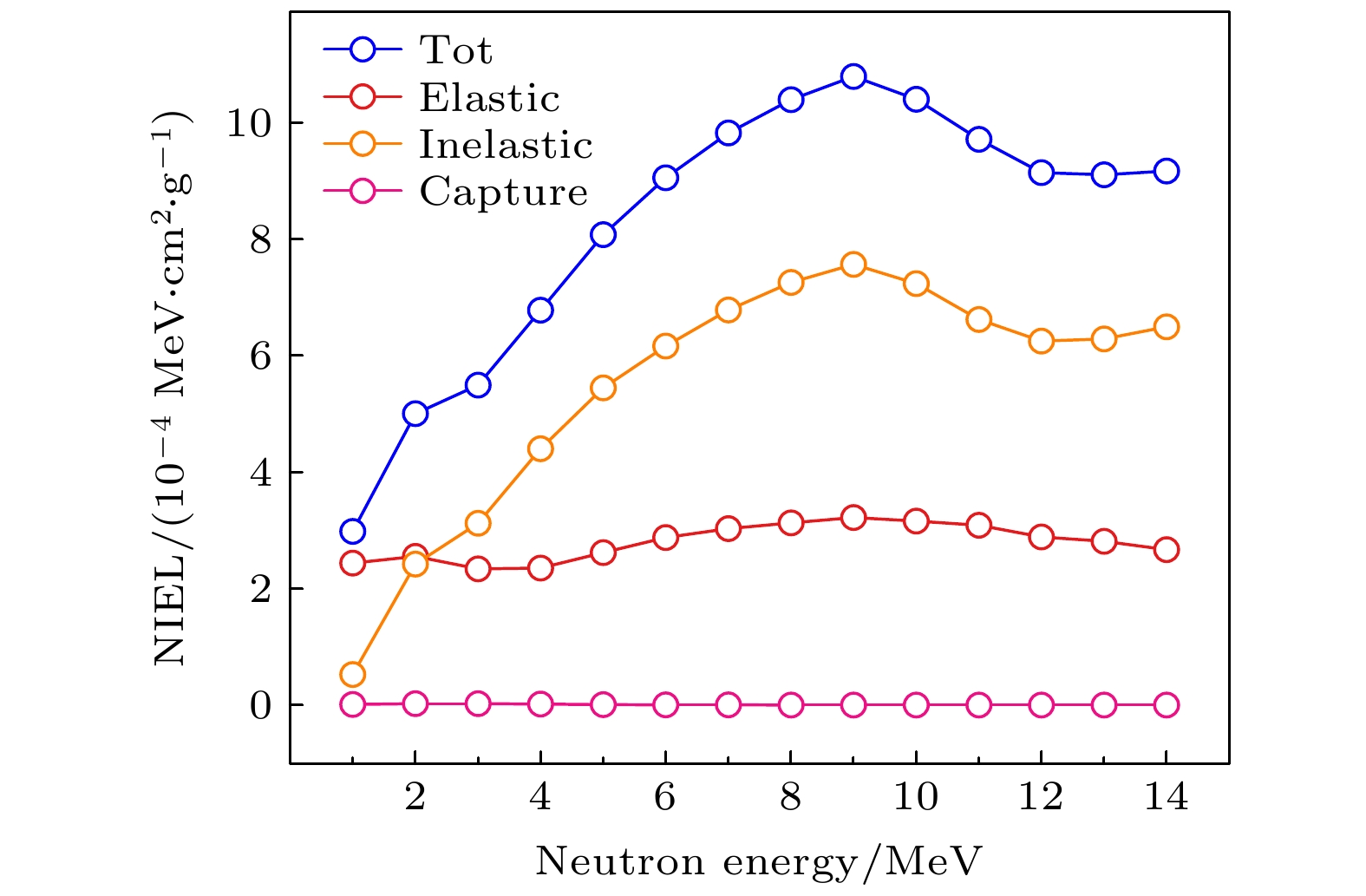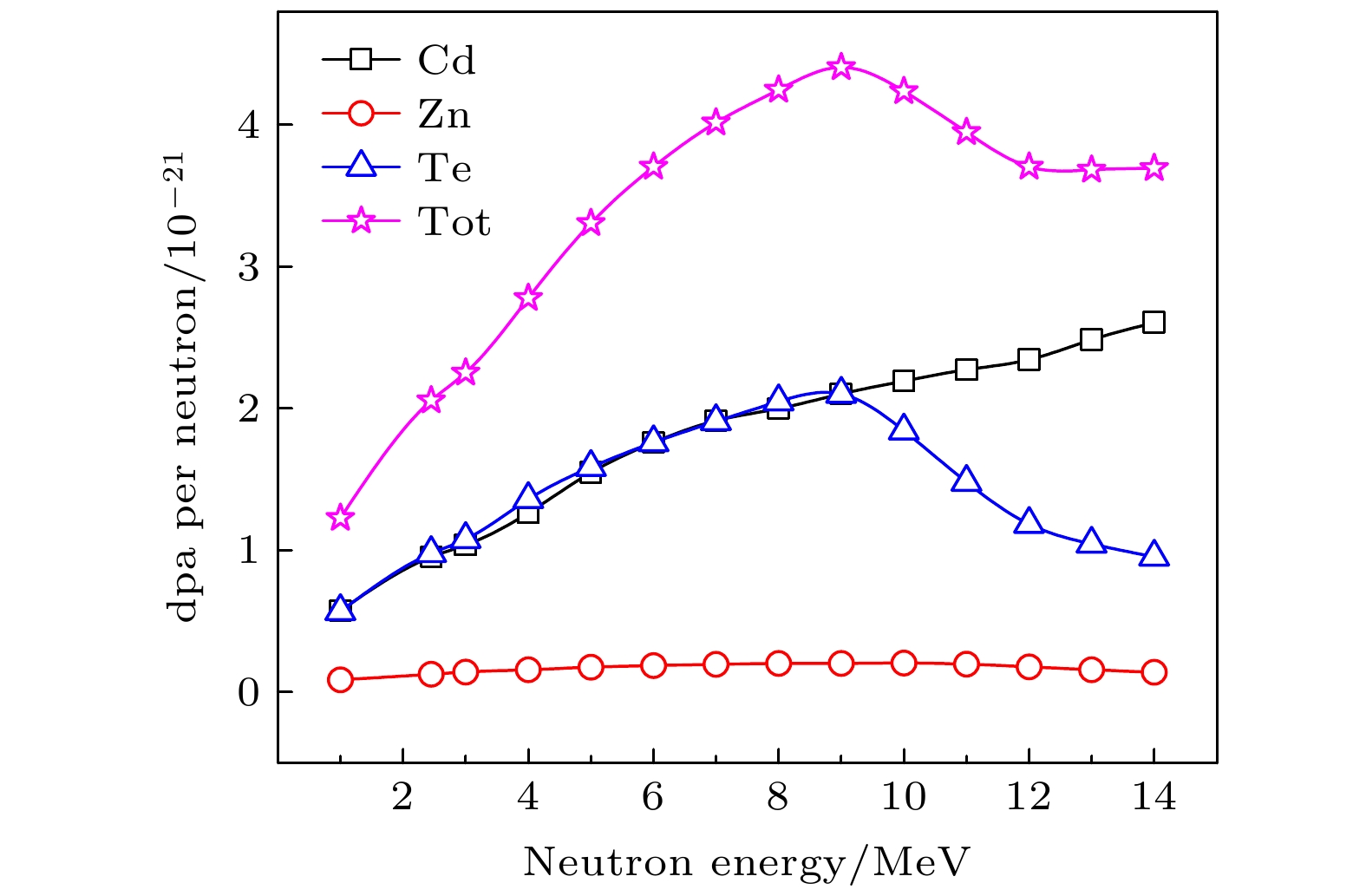-
In recent years, the development of new semiconductor materials has made an opportunity and challenge for technological innovation and the development of emerging industries. Among them, cadmium zinc telluride materials have highlighted important application prospects due to their excellent properties. The CdZnTe, as the third-generation cutting-edge strategic semiconductor material, has the advantages of high detection efficiency, low dark current, strong portability, and applicability at room temperature without additional cooling system. However, when the cadmium zinc telluride detector is exposed to radiation environment for a long time, it will cause different degrees of radiation damage, which will affect the performance of the device or even fail to work, and greatly shorten the service time of the detector in the radiation field. The transport process of 1.00–14.00 MeV neutrons in CdZnTe material is simulated to obtain the information about the primary knock-on atoms, and then by combining with the cascade collision model, the irradiation of neutrons with different energy in CdZnTe material is analyzed. The damage is simulated and calculated. The calculation results are shown below. The energy of most of the primary knock-on atoms is located at the low-energy end, and with the increase of the incident neutron energy, the types of primary knock-on atoms are more abundant, and the energy also increases gradually. With neutron irradiation of CdZnTe, the non-ionizing energy loss is uniformly distributed along the depth direction in the material, and the non-ionizing energy loss first increases and then decreases with the increase of the incident neutron energy. The calculation results of displacements per atom(dpa) show that the dpa also increases first with the increase of the incident neutron energy. And further analysis shows that the number of Te displacement atom atoms and the number of the Zn displacement atoms both increase first and decrease then with the increase of incident neutron energy, while the number of Cd displacement atoms increases with the increase of incident neutron energy, which is co-modulated by its inelastic scattering cross-section and other nuclear-like reaction cross-sections. The comprehensive analysis shows that with the increase of the incident neutron energy, inelastic scattering becomes the main factor causing the internal displacement damage of the material.
-
Keywords:
- neutron irradiation /
- CdZnTe /
- radiation damage /
- Geant4 simulation
[1] Alam M D, Nasim S S, Hasan S 2021 Prog. Nucl. Energy 140 103918
 Google Scholar
Google Scholar
[2] Takahashi T, Watanabe S 2001 IEEE Trans. Nucl. Sci. 48 950
 Google Scholar
Google Scholar
[3] Rao C V S, Shankara Joisa Y, Hansalia C J, Hui A K, Paul R, Ranjan P 1997 Rev. Sci. Instrum. 68 1142
 Google Scholar
Google Scholar
[4] Alper B, Dillon S, Edwards A W, Gill R D, Robins R, Wilson D J 1997 Rev. Sci. Instrum. 68 778
[5] Ingesson L C, Alper B, Peterson B J, Vallet J C 2008 Fusion Sci. Technol. 53 528
 Google Scholar
Google Scholar
[6] Yin Y, Li Y, Wang T, Huang C, Ye Z, Li G 2020 Sensors 20 E1294
 Google Scholar
Google Scholar
[7] Johns P M, Nino J C 2019 J. Appl. Phys. 126 040902
 Google Scholar
Google Scholar
[8] Gu Y, Jie W, Rong C, Wang Y, Xu L, Xu Y, Lv H, Shen H, Du G, Fu X, Guo N, Zha G, Wang T 2016 Nucl. Instrum. Methods Phys. Res. Sect. B Beam Interact. Mater. At. 386 16
 Google Scholar
Google Scholar
[9] Xu L, Jie W, Zha G, Xu Y, Zhao X, Feng T, Luo L, Zhang W, Nan R, Wang T 2013 Cryst. Eng. Comm. 15 10304
 Google Scholar
Google Scholar
[10] Bao L, Zha G, Gu Y, Jie W 2021 Mater. Sci. Semicond. Process. 121 105369
 Google Scholar
Google Scholar
[11] Eisen Y, Shor A 2009 IEEE Trans. Nucl. Sci. 56 1700
 Google Scholar
Google Scholar
[12] Bao L, Zha G, Xu L, Zhang B, Dong J, Li Y, Jie W 2019 Mater. Sci. Semicond. Process. 100 179
 Google Scholar
Google Scholar
[13] Bartlett L M, Stahle C M, Shu P K, Barbier L M, Barthelmy S D, Gehrels N A, Krizmanic J F, Kurczynski P, Palmer D M, Parsons A M, Teegarden B J, Tueller J 1996 Hard X-RayGamma-Ray Neutron Opt. Sens. Appl. 1996-07-19 pp10–16
[14] 李薇, 白雨蓉, 郭昊轩, 贺朝会, 李永宏 2022 物理学报 71 082401
 Google Scholar
Google Scholar
Li W, Bai Y R, Guo H X, He C H, Li Y H 2022 Acta Phys. Sin. 71 082401
 Google Scholar
Google Scholar
[15] 陈金勇 2014 硕士学位论文 (西安: 西安电子科技大学)
Chen J Y 2014 M. S. Thesis ( Xi'an: Xidian University) (in Chinese)
[16] 谢飞, 臧航, 刘方, 何欢, 廖文龙, 黄煜 2020 物理学报 69 192401
 Google Scholar
Google Scholar
Xie F, Zang H, Liu F, He H, Liao W L, Huang Y 2020 Acta Phys. Sin. 69 192401
 Google Scholar
Google Scholar
[17] 崔振国, 勾成俊, 侯氢, 毛莉, 周晓松 2013 物理学报 62 156105
 Google Scholar
Google Scholar
Cui Z G, Gou C J, Hou Q, Mao L, Zhou X S 2013 Acta Phys. Sin. 62 156105
 Google Scholar
Google Scholar
[18] Agostinelli S, Allison J, Amako K, et 2003 Nucl. Instrum. Methods Phys. Res. Sect. Accel. Spectrometers Detect. Assoc. Equip. 506 250
 Google Scholar
Google Scholar
[19] Allison J, Amako K, Apostolakis J, et al. 2006 IEEE Trans. Nucl. Sci. 53 270
 Google Scholar
Google Scholar
[20] Allison J, Amako K, Apostolakis J, et al. 2016 Nucl. Instrum. Methods Phys. Res. Sect. Accel. Spectrometers Detect. Assoc. Equip. 835 186
 Google Scholar
Google Scholar
[21] Srour J R, Marshall C J, Marshall P W 2003 IEEE Trans. Nucl. Sci. 50 653
 Google Scholar
Google Scholar
[22] 郝蕊静, 郭红霞, 潘霄宇, 吕玲, 雷志锋, 李波, 钟向丽, 欧阳晓平, 董世剑 2020 物理学报 69 207301
 Google Scholar
Google Scholar
Hao R J, Guo H X, Pan X Y, Lv L, Lei Z F, Li B, Zhong X L, Ouyang X P, Dong S J 2020 Acta Phys. Sin. 69 207301
 Google Scholar
Google Scholar
[23] 申帅帅, 贺朝会, 李永宏 2018 物理学报 67 182401
 Google Scholar
Google Scholar
Shen S S, He C H, Li Y H 2018 Acta Phys. Sin. 67 182401
 Google Scholar
Google Scholar
[24] Akkerman A, Barak J, Chadwick M B, Levinson J, Murat M, Lifshitz Y 2001 Radiat. Phys. Chem. 62 301
 Google Scholar
Google Scholar
[25] Liu Y, Zhu T, Yao J, Ouyang X 2019 Sensors 19 1767
 Google Scholar
Google Scholar
[26] 朱金辉, 韦源, 谢红刚, 牛胜利, 黄流兴 2014 物理学报 63 066102
 Google Scholar
Google Scholar
Zhu J H, Wei Y, Xie H G, Niu S L, Huang L X 2014 Acta Phys. Sin. 63 066102
 Google Scholar
Google Scholar
[27] Robinson M, Torrens I 1974 Phys. Rev. B 9 5008
 Google Scholar
Google Scholar
[28] Nordlund K, Zinkle S J, Sand A E, Granberg F, Averback R S, Stoller R E, Suzudo T, Malerba L, Banhart F, Weber W J, Willaime F, Dudarev S L, Simeone D 2018 J. Nucl. Mater. 512 450
 Google Scholar
Google Scholar
[29] Nordlund K, Zinkle S J, Sand A E, Granberg F, Averback R S, Stoller R, Suzudo T, Malerba L, Banhart F, Weber W J, Willaime F, Dudarev S L, Simeone D 2018 Nat. Commun. 9 1084
 Google Scholar
Google Scholar
[30] Bryant F J, Webster E 1967 Phys. Status Solidi B 21 315
 Google Scholar
Google Scholar
[31] Guo R, Xu Y, Wang T, Zha G, Jie W 2020 J. Appl. Phys. 127 024501
 Google Scholar
Google Scholar
-
表 1 不同能量中子辐照CZT产生PKA信息汇总表
Table 1. Summary of PKA generated by neutron incident Cd, Te, Zn.
Energy/
MeVElement Recoil atoms Ek Edam(T) Percentage/% 2.45 Cd 114Cd(12.57%) 112Cd(10.47%) 111Cd(5.57%) 113Cd(5.44%)
110Cd(5.33%) 116Cd(3.31%) 106—109, 115, 117Cd(0.98%)0.002 eV—
91.79 keV0.002 eV—
76.80 keV43.67 Te 130Te(18.43%) 128Te(16.58%) 126Te(9.94%) 125Te(3.71%) 124Te(2.51%)
122Te(1.32%) 120, 121, 123, 127, 129, 131Te(0.58%)0.03 eV—
81.05 keV0.03 eV—
69.68 keV53.05 Zn 64Zn(1.59%) 66Zn(0.93%) 68Zn(0.55%) 65, 67, 69—70Zn(0.15%) 1.33 eV—
150.18 keV1.29 eV—
102.91 keV3.23 Other 1H 4He 61, 64Ni 64Cu etc. 527.59 eV—
5.62 MeV492.12 eV—
239.7 keV0.05 14.00 Cd 112Cd(11.47%) 114Cd(10.38%) 113Cd(9.46%) 111Cd(8.68%) 110Cd(7.08%)
116Cd(2.66%) 109Cd(2.02%) 115Cd(1.47%) 105—108, 117Cd(1.12%)0.07 eV—
548.26 keV0.07 eV—
314.20 keV54.34 Te 130Te(13.88%) 128Te(13.17%) 126Te(7.87%) 125Te(2.85%) 124Te(2.02%)
122Te(1.10%) 120—121, 123, 127, 129, 131Te(0.41%)0.05 eV—
458.06 keV0.05 eV—
279.67 keV41.29 Zn 64Zn(1.30%) 66Zn(0.87%) 68Zn(0.54%) 65, 67, 69—70Zn(0.13%) 0.87 eV—
861.92 keV0.85 eV—
325.25 keV2.83 H 1H(0.71%) 2H(0.02%) 2.17 keV—
14.60 MeV313.33 eV—
1.69 keV0.73 Other 4He (0.26%) 61, 63—65, 67Ni 63—68, 70Cu 120—128, 130Sb 102—111, 113Pd
105—114, 116Ag 117, 119—123, 125, 127Sn etc.328.98 eV—
19.94 MeV315.24 eV—
0.66 MeV0.81 表 A1 中子入射CdZnTe产生的PKA详细信息汇总表
Table A1. Summary of PKA details generated by neutron incident CdZnTe.
Energy/
MeVElement Recoil atoms Ek Edam(T) Percen-
tage1.00 Cd 114Cd (13.61%), 112Cd (11.30%), 111Cd (6.00%)
113Cd(5.83%), 110Cd (5.80%), 116Cd (3.56%)
106—109, 115, 117Cd (1.06%)0.03 eV—37.49 keV 0.03 eV—32.95 keV 47.16% Te 130Te (16.79%), 128Te(15.86%), 126Te (9.30%) 125Te (3.51%),
124Te (2.40%), 122Te (1.27%) 120, 121, 123, 127, 129, 131Te (0.57%)0.02 eV—33.17 keV 0.02 eV—29.67 keV 49.69% Zn 64Zn (1.55%), 66Zn (0.87%), 68Zn (0.57%)
65, 67, 69—71Zn (0.15%)0.10 eV—61.31 keV 0.10 eV—47.55 keV 3.14% Other 4He, 61Ni, etc. 0.12—3.84 MeV 5.88—171.64 keV 0.01% 2.45 Cd 114Cd(12.57%), 112Cd(10.47%), 111Cd(5.57%) 113Cd(5.44%),
110Cd(5.33%), 116Cd(3.31%) 106—109, 115, 117Cd(0.98%)0.002 eV—91.79 keV 0.002 eV—76.80 keV 43.67% Te 130Te(18.43%), 128Te(16.58%), 126Te(9.94%) 125Te(3.71%),
124Te(2.51%), 122Te(1.32%) 120, 121, 123, 127, 129, 131Te(0.58%)0.03 eV—81.05 keV 0.03 eV—69.68 keV 53.05% Zn 64Zn(1.59%), 66Zn(0.93%), 68Zn(0.55%) 65, 67, 69—70Zn(0.15%) 1.33 eV—150.18 keV 1.29 eV—102.91 keV 3.23% Other 1H, 4He, 61, 64Ni, 64Cu, etc. 527.59 eV—5.62 MeV 492.12 eV—239.77 keV 0.05% 5.00 Cd 114Cd(12.56%), 112Cd(10.53%), 111Cd(5.60%) 110Cd(5.39%),
113Cd(5.32%), 116Cd(3.33%) 106—109, 115, 117Cd(0.93%)0.04 eV—187.28 keV 0.04 eV—147.18 keV 43.66% Te 130Te(17.82%), 128Te(16.26%), 126Te(9.67%) 125Te(3.61%),
124Te(2.45%), 122Te(1.30%) 120, 121, 123, 127, 129, 131Te(0.54%)0.02 eV—163.22 keV 0.02 eV—133.96 keV 51.65% Zn 64Zn(2.07%), 66Zn(1.26%), 68Zn(0.86%) 65, 67, 69—71Zn(0.21%) 0.20 eV—306.43 keV 0.20 eV—150.03 keV 4.39% Other 64, 66—67Cu, 103, 108Pd, 1H, 4He 61, 63—65 Ni, 106, 108Ag, etc. 163.93 eV—10.68 MeV 154.95 eV—368.6 keV 0.30% 10.00 Cd 114Cd(13.72%), 112Cd(13.72%), 110Cd(7.19%) 111Cd(5.30%),
113Cd(4.80%), 116Cd(3.44%) 106—109, 115, 117Cd(1.32%)0.04 eV—387.48 keV 0.04 eV—234.63 keV 49.08% Te 130Te(15.10%), 128Te(15.02%), 126Te(9.37%) 125Te(2.65%),
124Te(2.50%), 122Te(1.37%) 120, 123, 127, 129, 131Te(0.42%)0.02 eV—327.02 keV 0.02 eV—207.62 keV 46.42% Zn 64Zn(1.77%), 66Zn(1.15%), 68Zn(0.81%) 67, 69—70Zn(0.17%) 0.21 eV—614.56 keV 0.21 eV—256.14 keV 3.90% Other 1—2H(0.21%), 63—64, 66—68Cu(0.17%), 4He (0.10%) 61, 63—65 Ni,
102—103, 105, 107—108, 110Pd 117, 119—123, 127Sn, 106, 108, 110—114Ag
120, 122—126, 128, 130Sb, etc.1940.87 eV—15.72 MeV 554.83 eV—547.11 keV 0.60% 14.00 Cd 112Cd(11.47%), 114Cd(10.38%), 113Cd(9.46%) 111Cd(8.68%),
110Cd(7.08%), 116Cd(2.66%) 109Cd(2.02%), 115Cd(1.47%) ,
105—108, 117Cd(1.12%)0.07 eV—548.26 keV 0.07 eV—314.20 keV 54.34% Te 130Te(13.88%), 128Te(13.17%), 126Te(7.87%) 125Te(2.85%),
124Te(2.02%), 122Te(1.10%) 120—121, 123, 127, 129, 131Te(0.41%)0.05 eV—458.06 keV 0.05 eV—279.67 keV 41.29% Zn 64Zn(1.30%), 66Zn(0.87%), 68Zn(0.54%) 65, 67, 69—70Zn(0.13%) 0.87 eV—861.92 keV 0.85 eV—325.25 keV 2.83% H 1H(0.71%), 2H(0.02%) 2.17 keV—14.60 MeV 313.33 eV—1.69 keV 0.73% Other 4He (0.26%), 61, 63—65, 67 Ni, 63—68, 70Cu 120—128, 130Sb,
102—111, 113Pd, 105—114, 116Ag 117, 119—123, 125, 127Sn, etc.328.98 eV—19.94 MeV 315.24 eV—0.66 MeV 0.81% -
[1] Alam M D, Nasim S S, Hasan S 2021 Prog. Nucl. Energy 140 103918
 Google Scholar
Google Scholar
[2] Takahashi T, Watanabe S 2001 IEEE Trans. Nucl. Sci. 48 950
 Google Scholar
Google Scholar
[3] Rao C V S, Shankara Joisa Y, Hansalia C J, Hui A K, Paul R, Ranjan P 1997 Rev. Sci. Instrum. 68 1142
 Google Scholar
Google Scholar
[4] Alper B, Dillon S, Edwards A W, Gill R D, Robins R, Wilson D J 1997 Rev. Sci. Instrum. 68 778
[5] Ingesson L C, Alper B, Peterson B J, Vallet J C 2008 Fusion Sci. Technol. 53 528
 Google Scholar
Google Scholar
[6] Yin Y, Li Y, Wang T, Huang C, Ye Z, Li G 2020 Sensors 20 E1294
 Google Scholar
Google Scholar
[7] Johns P M, Nino J C 2019 J. Appl. Phys. 126 040902
 Google Scholar
Google Scholar
[8] Gu Y, Jie W, Rong C, Wang Y, Xu L, Xu Y, Lv H, Shen H, Du G, Fu X, Guo N, Zha G, Wang T 2016 Nucl. Instrum. Methods Phys. Res. Sect. B Beam Interact. Mater. At. 386 16
 Google Scholar
Google Scholar
[9] Xu L, Jie W, Zha G, Xu Y, Zhao X, Feng T, Luo L, Zhang W, Nan R, Wang T 2013 Cryst. Eng. Comm. 15 10304
 Google Scholar
Google Scholar
[10] Bao L, Zha G, Gu Y, Jie W 2021 Mater. Sci. Semicond. Process. 121 105369
 Google Scholar
Google Scholar
[11] Eisen Y, Shor A 2009 IEEE Trans. Nucl. Sci. 56 1700
 Google Scholar
Google Scholar
[12] Bao L, Zha G, Xu L, Zhang B, Dong J, Li Y, Jie W 2019 Mater. Sci. Semicond. Process. 100 179
 Google Scholar
Google Scholar
[13] Bartlett L M, Stahle C M, Shu P K, Barbier L M, Barthelmy S D, Gehrels N A, Krizmanic J F, Kurczynski P, Palmer D M, Parsons A M, Teegarden B J, Tueller J 1996 Hard X-RayGamma-Ray Neutron Opt. Sens. Appl. 1996-07-19 pp10–16
[14] 李薇, 白雨蓉, 郭昊轩, 贺朝会, 李永宏 2022 物理学报 71 082401
 Google Scholar
Google Scholar
Li W, Bai Y R, Guo H X, He C H, Li Y H 2022 Acta Phys. Sin. 71 082401
 Google Scholar
Google Scholar
[15] 陈金勇 2014 硕士学位论文 (西安: 西安电子科技大学)
Chen J Y 2014 M. S. Thesis ( Xi'an: Xidian University) (in Chinese)
[16] 谢飞, 臧航, 刘方, 何欢, 廖文龙, 黄煜 2020 物理学报 69 192401
 Google Scholar
Google Scholar
Xie F, Zang H, Liu F, He H, Liao W L, Huang Y 2020 Acta Phys. Sin. 69 192401
 Google Scholar
Google Scholar
[17] 崔振国, 勾成俊, 侯氢, 毛莉, 周晓松 2013 物理学报 62 156105
 Google Scholar
Google Scholar
Cui Z G, Gou C J, Hou Q, Mao L, Zhou X S 2013 Acta Phys. Sin. 62 156105
 Google Scholar
Google Scholar
[18] Agostinelli S, Allison J, Amako K, et 2003 Nucl. Instrum. Methods Phys. Res. Sect. Accel. Spectrometers Detect. Assoc. Equip. 506 250
 Google Scholar
Google Scholar
[19] Allison J, Amako K, Apostolakis J, et al. 2006 IEEE Trans. Nucl. Sci. 53 270
 Google Scholar
Google Scholar
[20] Allison J, Amako K, Apostolakis J, et al. 2016 Nucl. Instrum. Methods Phys. Res. Sect. Accel. Spectrometers Detect. Assoc. Equip. 835 186
 Google Scholar
Google Scholar
[21] Srour J R, Marshall C J, Marshall P W 2003 IEEE Trans. Nucl. Sci. 50 653
 Google Scholar
Google Scholar
[22] 郝蕊静, 郭红霞, 潘霄宇, 吕玲, 雷志锋, 李波, 钟向丽, 欧阳晓平, 董世剑 2020 物理学报 69 207301
 Google Scholar
Google Scholar
Hao R J, Guo H X, Pan X Y, Lv L, Lei Z F, Li B, Zhong X L, Ouyang X P, Dong S J 2020 Acta Phys. Sin. 69 207301
 Google Scholar
Google Scholar
[23] 申帅帅, 贺朝会, 李永宏 2018 物理学报 67 182401
 Google Scholar
Google Scholar
Shen S S, He C H, Li Y H 2018 Acta Phys. Sin. 67 182401
 Google Scholar
Google Scholar
[24] Akkerman A, Barak J, Chadwick M B, Levinson J, Murat M, Lifshitz Y 2001 Radiat. Phys. Chem. 62 301
 Google Scholar
Google Scholar
[25] Liu Y, Zhu T, Yao J, Ouyang X 2019 Sensors 19 1767
 Google Scholar
Google Scholar
[26] 朱金辉, 韦源, 谢红刚, 牛胜利, 黄流兴 2014 物理学报 63 066102
 Google Scholar
Google Scholar
Zhu J H, Wei Y, Xie H G, Niu S L, Huang L X 2014 Acta Phys. Sin. 63 066102
 Google Scholar
Google Scholar
[27] Robinson M, Torrens I 1974 Phys. Rev. B 9 5008
 Google Scholar
Google Scholar
[28] Nordlund K, Zinkle S J, Sand A E, Granberg F, Averback R S, Stoller R E, Suzudo T, Malerba L, Banhart F, Weber W J, Willaime F, Dudarev S L, Simeone D 2018 J. Nucl. Mater. 512 450
 Google Scholar
Google Scholar
[29] Nordlund K, Zinkle S J, Sand A E, Granberg F, Averback R S, Stoller R, Suzudo T, Malerba L, Banhart F, Weber W J, Willaime F, Dudarev S L, Simeone D 2018 Nat. Commun. 9 1084
 Google Scholar
Google Scholar
[30] Bryant F J, Webster E 1967 Phys. Status Solidi B 21 315
 Google Scholar
Google Scholar
[31] Guo R, Xu Y, Wang T, Zha G, Jie W 2020 J. Appl. Phys. 127 024501
 Google Scholar
Google Scholar
Catalog
Metrics
- Abstract views: 9679
- PDF Downloads: 216
- Cited By: 0















 DownLoad:
DownLoad:
